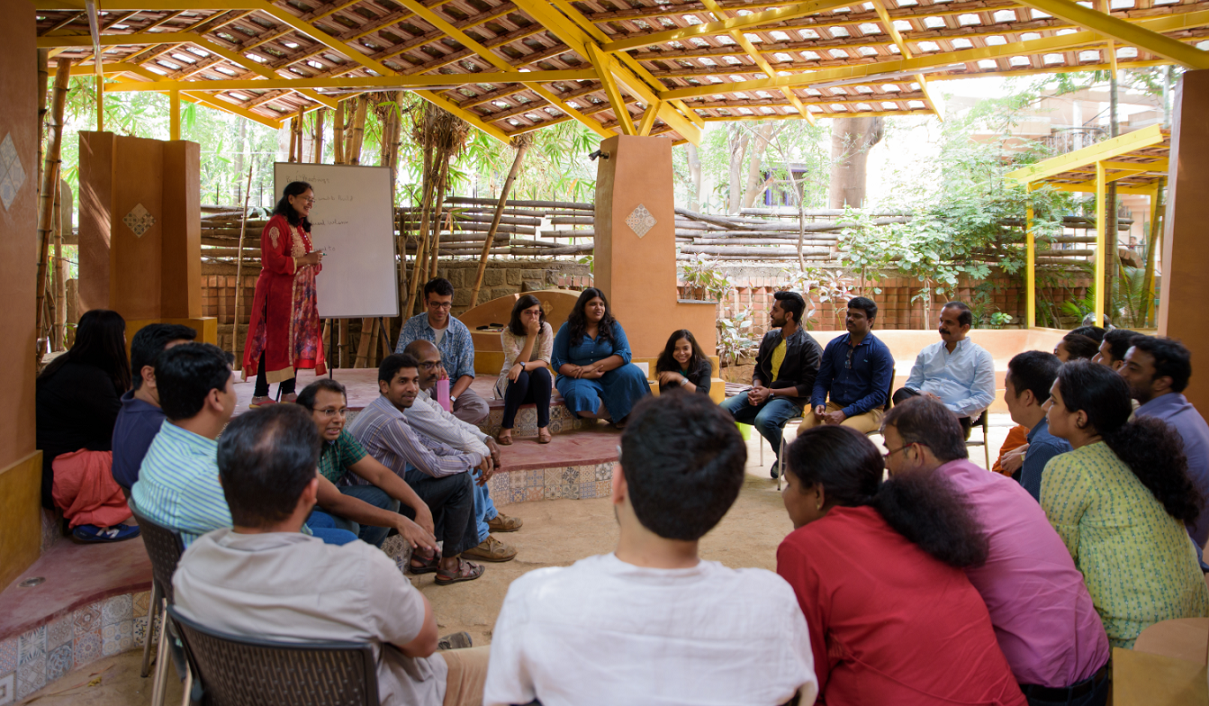In the commercial world, it’s trendy to talk about failing fast and often—and recovering faster. Young companies are constantly pivoting and iterating their products, services, and business models. The business world recognises that there can be no innovation without risk-taking and that taking risks comes with its fair share of failure. Why doesn’t the nonprofit world work like this?
In many developed countries, there has been a process of normalisation of failure in the course of business. In the nonprofit world, however—and particularly in India—things are different. Even though most leaders recognise the inevitability of failure and the valuable lessons it can teach us, they are not ready to admit it. This holds true across nonprofit organisations, corporate foundations, and philanthropies.
In 2020, our organisation India Development Review launched an initiative called Failure Files. Our ambition was to create a space where conversations around failure in the pursuit of social impact are more open and commonplace; where other players can learn from the experiences of their peers, so as to not repeat the same mistakes. Two years in, we have learned a lot about the perception of failure among nonprofits and philanthropies in India, the barriers to openly discussing setbacks, and what needs to happen in order to build a conducive environment for sharing vulnerabilities and challenges.

What are the barriers when it comes to speaking openly about failing?
1. Reputation risk
In India, from a young age, we are brought up worrying about ‘log kya kahenge’ (what will people say). In other words, culturally, we pay close attention to what our neighbours and friends approve of. This often guides our actions, or what we are comfortable communicating about our actions. And it naturally shows up in the social sector too.
Given that nonprofit leaders are attempting to solve complex problems of social change—most of which have moving goalposts—they are reticent to admit when things aren’t working. There is a legitimate concern around how they will be perceived, and what it might suggest about the capability of the leader. Abbas Dadla, ex-Programme Lead at Acumen Academy India, put it well: ‘I think the reasons (for not admitting failure) are the simplest and yet hardest to overcome: the need to be seen or perceived in a certain way, and one’s self-image, which is partly driven by the self and partly reinforced by society. In the social sector, we constantly feed into and reinforce a behaviour that celebrates achievements, awards, and recognitions. Even if we understand how others might benefit from us sharing our failures publicly, we don’t see the upsides for ourselves, only the downsides.’
2. Organisational culture
The culture of an organisation also plays a big role in determining how much failure is spoken about, how frequently, and in whose presence. Within any organisational setup, the way incentives and rewards are designed impacts how individuals and teams function. If the leader does not encourage a culture of learning and openness, it will percolate throughout the organisation.
Shruthi Iyer, CEO of the Foundation for Mother and Child Health, talked about the challenges that come with speaking publicly about failing, as a woman. ‘Gender plays a role. As a woman leader, there is an added hesitancy to talk about failures because people already believe that you’re ‘soft’ and ‘vulnerable’. And so, if you talk about failure, you worry that it’s yet another reason why you won’t be taken seriously as a leader.’
It’s important to create a culture of learning within organisations, so that teams feel comfortable to candidly talk about their failures.
In 2020, Shruthi wrote an article for Failure Files, that chronicles a year where, in spite of achieving the outward markers of success, she failed as a leader, colleague, daughter, friend, and partner. She admits that it was easier to talk about the failure publicly after having moved on from the organisation, and after having built an ecosystem of support around herself. In particular, she found it helpful to look at examples of other women leaders who had failed to know that she was not alone. While she continues to work on this, she believes that it’s also important to create a culture of learning within organisations, so that teams feel comfortable to candidly talk about their failures.
‘Even after I open up about my own failure, I often ask myself: what is the culture that my organisation has around failure? Does my team understand that it’s okay to fail? Am I able to actively communicate with them that we failed? And beyond the team, will I be able to have these conversations with my board, donors, and other stakeholders?’
3. Skewed funder-nonprofit power dynamic
India reportedly has 3.5 million nonprofit organisations, spread across 30 states, and more than 600 districts, serving hundreds of millions of people. All of them end up competing for the same insufficient pool of funds from individual philanthropists, corporate social responsibility budgets, bilateral and multilateral agencies, and foundations. The resulting gap between demand and supply in a highly resource-constrained sector accentuates the already uneven power dynamic between funders and grantees.
What complicates matters further is that often, funders want a majority of their grant (if not all of it) to go towards the programme and the community being served. This leaves little room for operating expenses, let alone experimentation and innovation. In other words, the appetite for failure is negligible. And so, nonprofit leaders play it safe, afraid that admitting failure might endanger subsequent grants.
The entire ecosystem, by upholding this façade of success and impact, is inadvertently maintaining a status quo of silence around failure.
Huda Jaffer, Director of SELCO Foundation, caveats this by adding that this is not set in stone and that there is room for nonprofits to manoeuvre, based on the kind of funder. ‘Whether or not funders are open to learning from failure also depends on the kind of funder and their mandate. In our experience, it is much harder for bilateral and multilateral funding agencies to create efficient feedback and learning loops with their partners, because their structures may only allow for change over a period of time. In contrast, we found philanthropists and family foundations can have more of a continuous learning mindset and be better candidates for funding failure. The kind of capital source, i.e, whether it’s taxpayer or public monies versus private capital does also drive the room that the leadership would have to revise priorities and consistently mirror learnings from the ground.’
The responsibility, however, doesn’t lie on funders or nonprofits alone. Somehow the entire ecosystem, by upholding this façade of success and impact, is inadvertently maintaining a status quo of silence around failure.
Anish Kumar, Co-lead at Transform Rural India Foundation, believes that we cannot effectively do development work if we aren’t talking about our failures, because there is no way to pursue social impact without risk-taking and innovation.
‘Given the externalities that the development sector grapples with our rate of failure should be higher than that of for-profit enterprises or start-ups. And yet, everyone is complicit, in a sense, of maintaining this charade and not talking about this fundamental truth of our work. The pressure on everyone—from programme officers at funding organisations to grantee partners—to have to report impact has implications for how honest we are, and what we can learn from things that don’t work. And so we see a tendency to downplay the real risks of a project and frame it in such a way that allows the proposal and grant to get approved.’
What needs to change
1. We need a new narrative around failure
We need a mindset and narrative shift when it comes to failure. Making it more neutral and framing the language around ‘lessons’ rather than ‘failure’ could help people articulate what not to do and how to do better next time. We took this approach when we started Failure Files and have found that it has made a difference in how people tell their stories, and how they are received by the ecosystem.
For instance, Manjot Kaur reflected on how she learned to be a braver and more compassionate leader after her organisation failed to meet its goals in part due to her authoritative leadership style. Similarly, after getting caught in an unhealthy power dynamic with a funder, Dilip Pattubala wrote about how he learnt the importance of taking difficult decisions and staying true to his organisation’s vision—lessons that helped his organisation successfully navigate the Covid-19 pandemic.
We also need to recognise that failure is highly contextual; it’s time-dependent (programmes that may appear to be failing at one juncture could end up being successful at a later point); and closely related to the benchmarks of success we ascribe ourselves. Just because we failed at achieving those benchmarks, doesn’t mean there wasn’t progress on other measures.
2. We need to create safe spaces for honest conversations
SELCO Foundation hosts a conclave focused on celebrating lessons that emerge from failures in development work. According to Rachita Misra, Associate Director for Knowledge and Advocacy at SELCO Foundation, ‘While closed-door conversations help you accept your failure, they don’t lead to larger changes within the ecosystem. For learning to happen, the dissecting of what worked and what didn’t need to happen effectively and shared publicly.’ Shruthi adds, ‘It’s important that these spaces practice non-judgmental listening and that there are fewer people mansplaining what I did wrong. Instead, I see these as opportunities to listen to and learn from other people’s failures, particularly the failures of established leaders.’
The Acumen Academy fellowship has also been doing this with their cohort of leaders for a few years now. Every year, they work with a new cohort to build an environment of trust and community, so that their fellows can openly share their challenges, and what’s not working. ‘We help Fellows unpack their beliefs that are no longer serving them, [the] assumptions and behaviours that are holding them back, and we help them reset after setbacks,’ says Abbas.
Lastly, within organisations too, it is the leadership’s responsibility to foster a culture of learning and reflection, so mistakes can be identified, and rectified quickly.
3. It needs to be a collective effort, and funders have a big role to play
Huda believes that ‘When a funder brings openness, flexibility, and transparency to the table, it allows the nonprofit to not only share their learning but also to capture them and build processes for that feedback to get incorporated into their work.’
Rachita adds that starting conversations on failure is a joint responsibility of the funder and the nonprofit partner’s leadership. ‘Leaders also need to make sure that there is a diversity of funders and take steps towards ensuring that the culture of the organisation is not defined by any one type of funder. Initiating conversations on failure needs to come equally from both parties; one-sided conversations are not sustainable.’
Finally, acknowledging and openly discussing failures cannot be a singular pursuit by one entity. It needs to be a collective effort, so that lessons that emerge can benefit a range of stakeholders across the ecosystem, and most importantly, the communities that they exist to serve.
This article was originally published in Alliance magazine.






